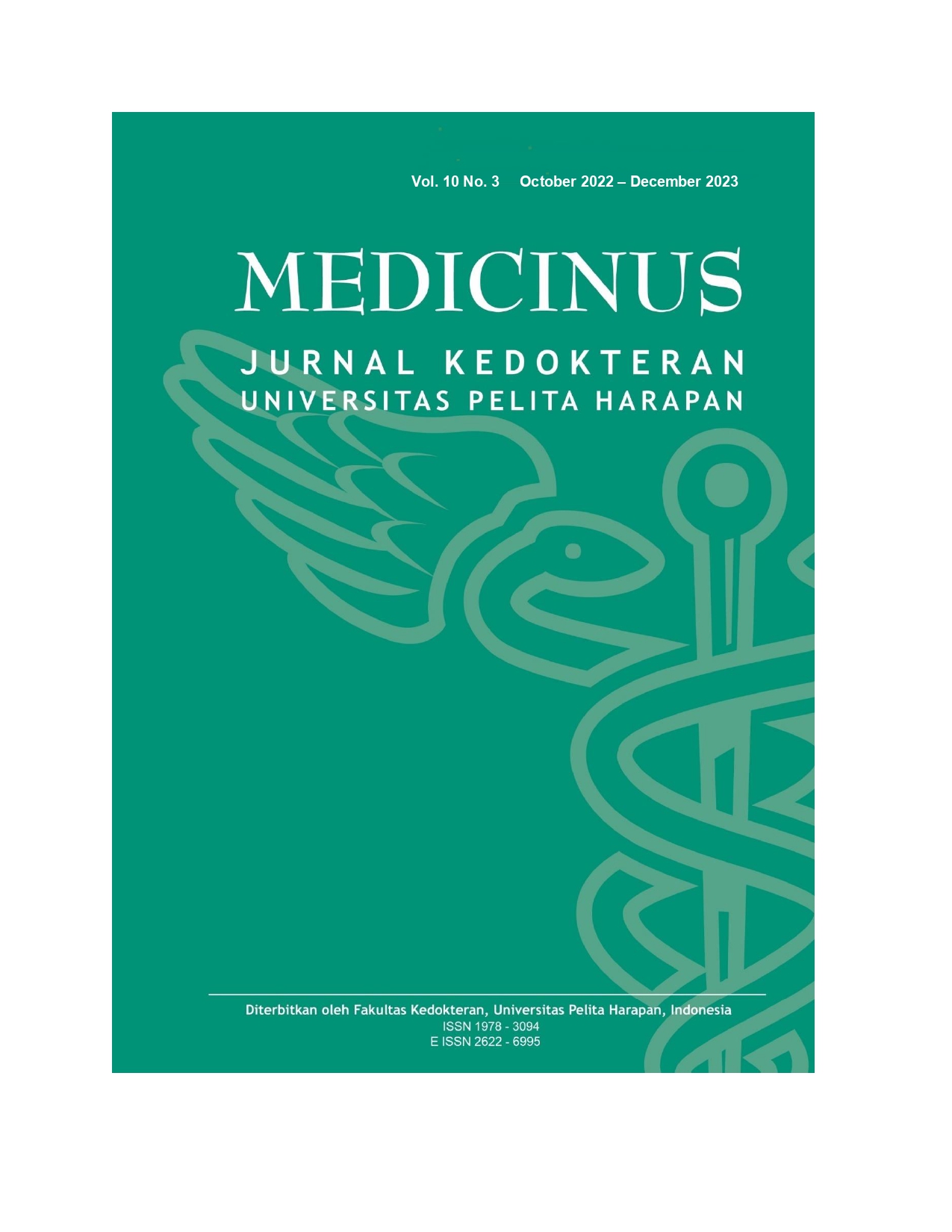Relationship of Sexual Violence to Depression in Female Students of Faculty of Medicine, Pelita Harapan University
DOI:
https://doi.org/10.19166/med.v10i3.7035Keywords:
Sexual violence, Depression, Female studentsAbstract
Background: Sexual violence can take many forms to anyone. The increase in the number of sexual violence against women in Indonesia is quite significant. These incidents are reported to occur frequently in women in young adulthood. These experiences can have long-term effects, one of which is depression. There are several studies that show an association between sexual violence and the incidence of depression. However, there has not been much quantitative research to look at the relationship on this matter in Indonesia, especially on female students. This study aims to understand the relationship between sexual violence and the incidence of depression in female students of the Faculty of Medicine, Universitas Pelita Harapan.
Methods: This study use a cross-sectional study design. The data has been collected using questionnaires filled in by the respondents. This study involved 149 female students of the Faculty of Medicine, Pelita Harapan University. The results of the study were processed and statistically analyzed using SPSS 25.
Result: Based on research data, there are 149 respondents from female students of the Faculty of Medicine, Universitas Pelita Harapan. with a mean age of 19.29 (SD = 1.086). The youngest age of the respondent is 17 years old and the oldest is 24 years old. A total of 55 respondents had experienced sexual violence. Based on the results of the Beck's Depression Inventory (BDI) questionnaire, 16% had mild depression, 9% had moderate depression, and 2% had severe depression. Chi-square test showed a significant relationship between experiences of sexual violence and the incidence of depression, with p <0.001.
Conclusions: Sexual violence is related to the incidence of depression in female students of the Faculty of Medicine, Pelita Harapan University.References
1. Komnas Perempuan. Bentuk Kekerasan Seksual. 2017
2. Conley AH, Overstreet CM, Hawn SE, Kendler KS, Dick DM, Amstadter AB. Prevalence and predictors of sexual assault among a college sample. Journal of American College Health [Internet]. 2017 Jan 2 [cited 2020 Nov 14];65(1):41-9. https://doi.org/10.1080/07448481.2016.1235578
3. Komnas Perempuan. Catatan Tahunan tentang Kekerasan terhadap Perempuan. Jakarta; 2020.
4. Houle JN, Staff J, Mortimer JT, Uggen C, Blackstone A. The Impact of Sexual Harassment on Depressive Symptoms during the Early Occupational Career. Society and Mental Health. 2011;1(2):89-105. https://doi.org/10.1177%2F2156869311416827
5. Mushtaq M, Sultana S, Imtiaz I. The Trauma of Sexual Harassment and its Mental Health Consequences Among Nurses. Journal of The College of Physicians and Surgeons . 2015;25(9):675-79. https://doi.org/09.2015/jcpsp.675679
6. Yüce M, Karabekıroğlu K, Yildirim Z, Şahın S, Sapmaz D, Babadaği Z, et al. The psychiatric consequences of child and adolescent sexual abuse. Noropsikiyatri Arsivi [Internet]. 2015 Dec 1;52(4):393-9. https://doi.org/10.5152/npa.2015.7472
7. Tarzia L, Maxwell S, Valpied J, Novy K, Quake R, Hegarty K. Sexual violence associated with poor mental health in women attending Australian general practices. Australian and New Zealand Journal of Public Health. 2017 Oct 1 [cited 2020 Dec 6];41(5):518-23. https://doi.org/10.1111/1753-6405.12685
8. Sari IP. KEKERASAN DALAM HUBUNGAN PACARAN DI KALANGAN MAHASISWA : STUDI REFLEKSI PENGALAMAN PEREMPUAN. Vol. 7, DIMENSIA: Jurnal Kajian Sosiologi. 2018 Aug.
9. Marwick K, Birrell S. Crash Course Psychiatry 5th Edition. 5th ed. Elsevier; 2019.
10. Sadock BJ. Synopsis of Psychiatry. 11th ed. Wolters Kluwer; 2015.
11. Breton JJ, Labelle R, Berthiaume C, Royer C, St-Georges M, Ricard D, et al. Protective factors against depression and suicidal behaviour in adolescence. Canadian journal of psychiatry Revue canadienne de psychiatrie. 2015 Feb 1; 60(2):S5-15. http://www.ncbi.nlm.nih.gov/pmc/articles/pmc4345848/
Downloads
Published
How to Cite
Issue
Section
License
Copyright (c) 2023 Luqyana Ghina Xaviera, Erna Kristiani, Neneng Suryadinata

This work is licensed under a Creative Commons Attribution-ShareAlike 4.0 International License.
Authors who publish with this journal agree to the following terms:
1) Authors retain copyright and grant the journal right of first publication with the work simultaneously licensed under a Creative Commons Attribution License (CC-BY-SA 4.0) that allows others to share the work with an acknowledgement of the work's authorship and initial publication in this journal.
2) Authors are able to enter into separate, additional contractual arrangements for the non-exclusive distribution of the journal's published version of the work (e.g., post it to an institutional repository or publish it in a book), with an acknowledgement of its initial publication in this journal.
3) Authors are permitted and encouraged to post their work online (e.g., in institutional repositories or on their website). The final published PDF should be used and bibliographic details that credit the publication in this journal should be included.





